Key Takeaways
- Incorporating blockchain technology is key to addressing the current challenges in the energy sector, including scalability, higher energy costs, and environmental issues;
- The integration of blockchain with the energy sector enables streamlined peer-to-peer energy trading, secured carbon credit tracking, and broader energy investment opportunities;
- Many leading energy companies have implemented blockchain technology to help encourage people to use renewable energy.
Stop overpaying - start transferring money with Ogvio. Sign up, invite friends & grab Rewards now! 🎁
Blockchain for energy has become a game-changer for transforming the approach to energy production, distribution, and consumption. It’s tackling big issues like rising costs, environmental impact, and the need for better security and transparency.
Take energy transactions, for example. With energy blockchain, these transactions can be secured and automated using crypto tokens, making the whole process smoother. This is where platforms like Binance, Kraken, or Bybit come into play, helping facilitate these exchanges.
If you’re interested in finding out how blockchain technology is changing the energy sector, you’re in the right place. From understanding the basics of the blockchain energy sector to the benefits and real-world applications, I’ve got you covered. Plus, you’ll see how energy companies are already leveraging blockchain technology. So, let’s get started!

Did you know?
Subscribe - We publish new crypto explainer videos every week!
Harmony ONE Explained (Beginner-Friendly Animation)


Table of Contents
- 1. Blockchain for Energy Overview
- 2. Blockchain in the Energy Sector Applications
- 2.1. Peer-to-Peer Energy Trading
- 2.2. Smart Grid Management
- 2.3. Carbon Credit Trading
- 2.4. Renewable Energy Certificates
- 2.5. Energy Tokenization
- 2.6. Energy Supply Chain
- 3. Advantages of Utilizing Blockchain in the Energy Sector
- 4. Energy Companies Using Blockchain Technology
- 4.1. Shell
- 4.2. Siemens Industry Inc.
- 4.3. Powerledger
- 5. Conclusions
Blockchain for Energy Overview
The first step to discovering the role of blockchain for energy is to understand its fundamentals.
Latest Deal Active Right Now:A blockchain is a database or ledger that allows secure and transparent transactions within a distributed network. This technology has several key characteristics that make it unique compared to traditional databases:
- Decentralized: Most blockchains operate without a central authority, meaning nodes or connected computers store and validate the information.
- Consensus: This technology relies on consensus mechanisms like Proof-of-Work (PoW) and Proof-of-Stake (PoS) to validate transactions.
- Transparency and immutability: Transactions recorded on a blockchain are visible to all network participants and can’t be deleted or altered.
- High-level security: Due to its decentralized nature, this distributed database is robust against cyber attacks and data manipulation.
- Smart contracts: Blockchain technology uses smart contracts that automatically execute transactions when pre-determined terms are met.
Now, let’s discuss blockchain in the energy sector. One of the primary purposes of blockchain for energy is to automate the production and exchange of renewable energy credits and certificates based on actual energy use.

Energy companies can use cryptocurrency to facilitate energy production, distribution, and consumption transactions. One common application of blockchain technology is tokenizing energy assets, making energy units like kilowatt-hours as digital tokens on a blockchain.
You can purchase, sell, or trade them on a cryptocurrency exchange. Binance, Kraken, and Bybit offer a service to view the price index and trade popular energy tokens, such as Powerledger (POWR), SunContract (SNC), and Dione Protocol (DIONE).
Blockchain in the Energy Sector Applications
There are many use cases of blockchain for energy sector. This chapter will cover six practical blockchain applications in the energy sector.
Peer-to-Peer Energy Trading
The main idea of peer-to-peer (P2P) energy trading is that people can directly buy and sell energy assets from each other without relying on a central utility company. P2P energy trading lets you decide from or to whom you want to purchase and sell energy products.
Benefits of Peer-to-Peer Energy Trading
P2P energy trading aims to make renewable energy more accessible while encouraging consumers to utilize their energy sources effectively. It also brings several benefits to the energy sector:
- Empowered consumers: P2P energy trading can help people to become “prosumers”, those who produce and consume energy. Therefore, people with solar panels or other renewable energy sources can sell their excess electricity to their neighbors at a lower cost.
- Financial benefits: With P2P energy trading, consumers can save money on electricity bills by purchasing from their neighbors at competitive prices. Additionally, producers will earn extra income from selling their surplus renewable energy.
- Efficient grid management: Local energy trading allows nearby consumers to utilize excess power generation from the traditional power grid. It also helps improve grid stability and reduce energy congestion, where the lowest-cost electricity cannot reach some consumers.
- Increase renewable energy usage: P2P energy trading can encourage people to invest in renewable energy sources by making them financially rewarding and more accessible. This also helps decrease reliance on fossil fuels.
Innovative technology is crucial to make these P2P energy trading more seamless and secure. This is where blockchain comes in, providing a robust solution for managing decentralized energy trades.

Blockchain’s Role in Peer-to-Peer Energy Trading
Blockchain technology can significantly improve this system by offering several advantages. It securely records all energy transactions between producers and consumers, making the process more transparent and efficient.
Smart contracts, computer codes that facilitate agreements based on predefined conditions[1], can further streamline peer-to-peer energy trading. These contracts can automatically manage tasks like grid balancing, payments, and price setting, ensuring a smooth trading experience.
Smart Grid Management
Now, let’s discuss smart grid management. But what exactly is a smart grid? A smart grid is an upgraded electricity network that uses advanced technology to manage how power is produced and used[2]. It involves three types of participants: generators (who produce electricity), consumers (who use it), and prosumers (who can do both).
Furthermore, the fundamental technology that enables smart grids is called smart meters or advanced metering infrastructure (AMI). This technology allows two-way communication between energy producers and consumers.
Benefits of Smart Grids
There are many benefits of building a smart grid. They are:
- Improved distributed resource performance: Smart grids can actively manage demand and supply, ensuring output from distributed resources is used as effectively as possible.
- Fewer electricity losses: The ability to better integrate distributed energy resources means that smart grids can reduce electricity losses by keeping both demand and supply local.
- Improved reliability: Smart grids can detect and respond to issues on the grid network faster, which can help prevent outages or shorten their duration.
- Reduced service costs: Smart grids can help consumers reduce energy bills by allowing them to shift their energy use to off-peak hours.
As smart grids become more advanced, handling all the data can be challenging. Blockchain technology offers solutions to address this issue.

Blockchain’s Role in Smart Grid Management
Managing smart grid systems can be challenging. That’s because they generate a massive amount of data that needs to be securely collected and analyzed to optimize the grid in real time. Therefore, implementing energy blockchain can help improve smart grid management processes.
With more renewable energy sources coming online, implementing adaptable power grids is crucial to handling power generation fluctuation. Fortunately, blockchain’s smart contracts can help automate processes to optimize energy demand and balance supply in real time.
Implementing blockchain in utilities can help energy companies shift from traditional centralized control to a decentralized energy management system. The system can optimize renewable energy generation, distribution, and storage across the power grid, allowing companies to balance energy supply and demand dynamically.
Carbon Credit Trading
Carbon trading or carbon emissions trading involves buying and selling credits that permit a company to emit a certain amount of carbon dioxide. Governments fully authorized the carbon trade and carbon credits to reduce carbon emissions.
Many regional exchanges are used for carbon trading. The largest is the Shanghai Environment and Energy Exchange. Other exchanges include the AirCarbon Exchange in Singapore and Xpansiv CBL in New York.
Benefits of Carbon Trading
Carbon trading is a powerful tool for positive change in the energy sector. Here are several of its notable benefits:
- Encourages investment in clean energy: Carbon trading creates a financial incentive for companies exceeding emission limits to invest in cleaner technologies like renewables.
- Increases energy efficiency: It encourages consumers and businesses to use energy more efficiently, as carbon pricing can increase electricity prices.
- Supports green development: A well-designed carbon market brings more profits toward renewable energy projects.
- Reduces overall emissions: By putting a price tag on carbon, companies are pushed to reduce their emissions.
As the carbon market grows, better ways are needed to track and manage these credits. Blockchain technology can address this issue by providing greater transparency and efficiency.
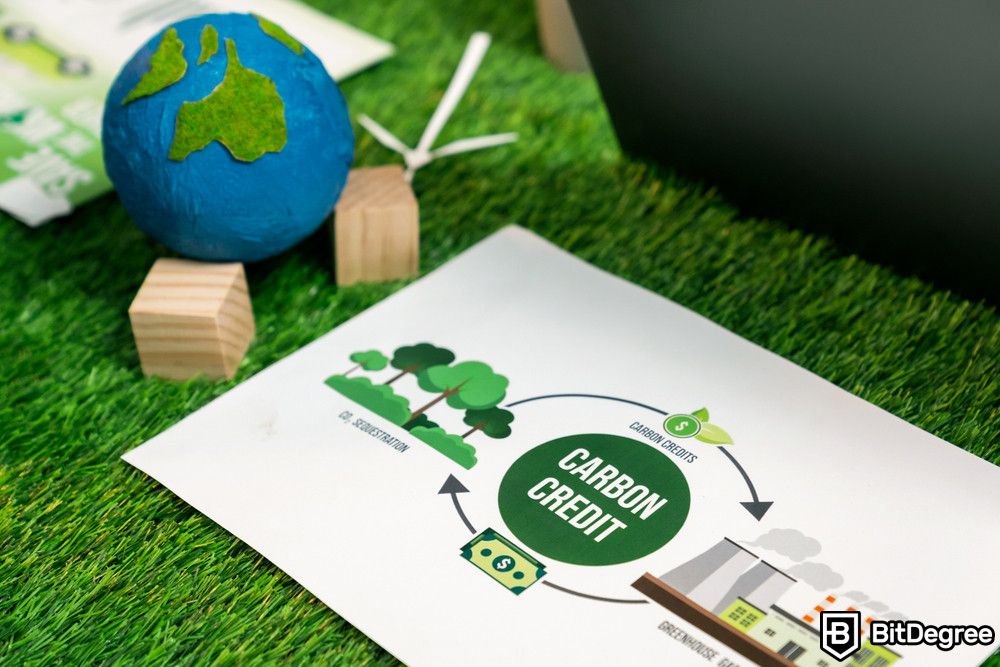
Blockchain’s Role in Carbon Credit Trading
Blockchain energy is transforming carbon credit trading by making it efficient and transparent. Tracking carbon credits can be complex and prone to fraud. This technology ensures that every credit is recorded on an immutable ledger, making it easier to verify the history of each credit.
Energy companies can securely track carbon credits since blockchain records are tamper-proof. It greatly decreases the risk of double-counting as each credit reflects the actual reduction in greenhouse emissions. Blockchain’s smart contracts also help eliminate intermediaries, lower costs, and speed up trading.
Moreover, energy companies and individuals can easily enter the market, as blockchain in utilities lowers entry barriers. This broad participation is vital for fighting climate change, as it lets more people help decrease gas emissions.
Renewable Energy Certificates
Another use case of blockchain in the energy sector is the use of Renewable Energy Certificates (RECs). They are tradable instruments that prove one megawatt-hour (MWh) of electricity was generated from a renewable energy source and added to the grid.
RECs verify and track renewable energy production and consumption. They also encourage the development of renewable energy projects by incentivizing producers.
Individuals and businesses can buy and sell RECs in voluntary markets. Purchasing RECs allows them to claim they are using renewable energy. This is especially important for those committed to sustainability goals.
Benefits of Renewable Energy Certificates
Renewable energy certificates offer several key benefits, such as:
- Flexibility: RECs let businesses and individuals support renewable energy generation regardless of their location. Therefore, you can buy RECs from renewable projects anywhere.
- Environmental impact: RECs promote clean energy sources and help cut greenhouse gas emissions and other conventional electricity generation pollutants.
- Market incentives: Purchasing RECs creates a market demand for renewables, incentivizing further investment and development of renewable energy projects.
Even though renewable energy certificates are useful on their own, implementing innovative technologies can make them more effective. Using blockchain for energy in managing RECs helps increase transparency, efficiency, and security in the renewable energy market.

Blockchain’s Role in Renewable Energy Certificates
Blockchain creates a distributed digital database that records every renewable energy certificate transaction. All participants have access to the same information, which can help prevent fraud and ensure the authenticity of REC transactions.
Smart contracts can make REC issuance and trading easier and more efficient. They automate processes and keep transparent records, boosting efficiency and security.
Additionally, another role of blockchain for renewable energy certificates is the ability to improve market accessibility and liquidity. Companies and individuals can seamlessly trade RECs across countries.

Did you know?
Subscribe - We publish new crypto explainer videos every week!
What is a Bitcoin & How Does it work? (Animated Explainer)
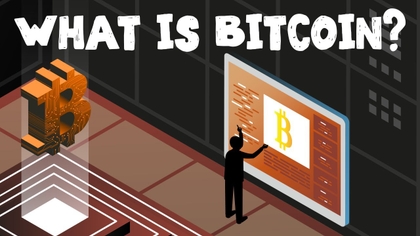

Energy Tokenization
Energy tokenization refers to converting tangible energy assets like wind power or solar panels into digital tokens on a blockchain network. This approach streamlines real-world use cases, including improved grid management, peer-to-peer energy trading, and renewable energy certificates.
Benefits of Energy Tokenization
Tokenization in the energy sector is changing how we interact with energy assets. It offers several potential benefits:
- Improved liquidity: The blockchain energy sector can streamline transactions for investors to buy and sell energy tokens, thus increasing liquidity in the industry.
- Increased investment opportunities: Tokenization enables the separation of energy assets, meaning that even investors with limited financial resources can participate in renewable energy projects.
- Better grid management: Blockchain-based systems can improve grid management through real-time energy supply and demand monitoring.
Energy tokenization not only enhances liquidity and investment but also transforms energy consumption and management. Through blockchain technology, the energy sector can improve its efficiency and transparency.
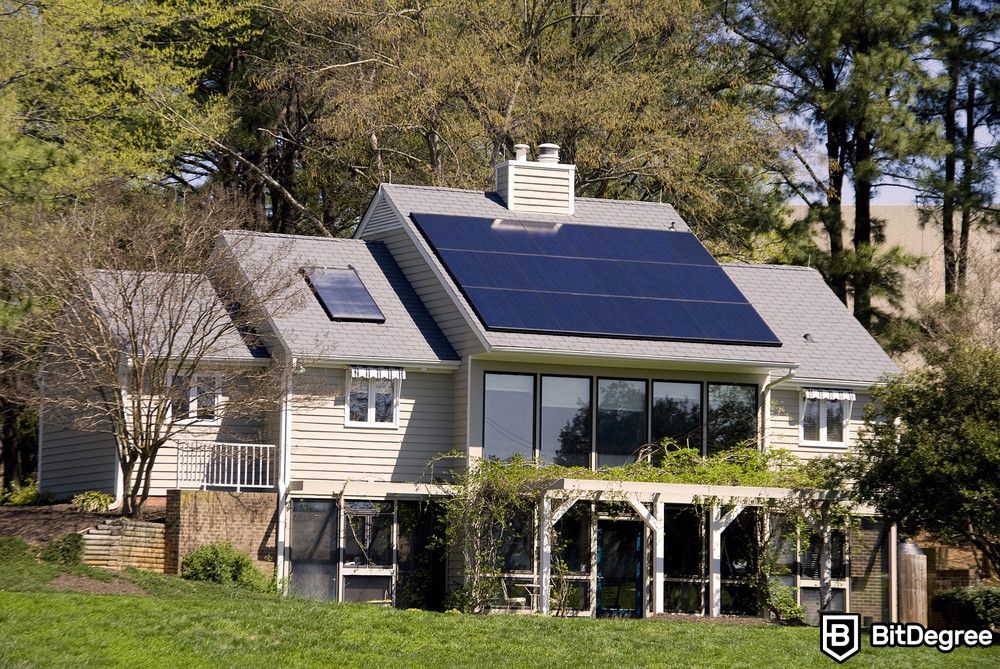
Blockchain’s Role in Energy Tokenization
Let’s say you have solar panels as your main energy source. Blockchain energy helps measure how much power your panels generate and converts that data into digital tokens, representing the energy they produce.
The magic of blockchain for energy lies in its transparency and security. Once energy tokens are created, they will be stored on a blockchain network. This means that no intermediary can monitor the transactions, and all participants in the network can see them.
Blockchain also streamlines energy token trading, so you can seamlessly sell excess tokens to others. Moreover, blockchain helps track the source of energy tokens, meaning you can trace where they come from.
Energy Supply Chain
The energy supply chain refers to getting energy from its source to the end-users or consumers.
The process involves three main stages. The first process is upstream, where the raw energy sources are produced. This includes mining coal, harvesting solar energy, or drilling for oil.
Once extracted, the raw energy is transported and processed. This stage is called midstream, and it involves refineries, pipelines, power grids, and storage facilities. The final stage, or downstream, is to deliver the energy to consumers. This could be a gas station selling gasoline or a power plant providing electricity to households.
Benefits of Energy Supply Chain
An efficient energy supply chain has advantages for the environment and economy. Here’s a breakdown of several key benefits:
- Environmental benefit: A well-managed energy supply chain plays a significant role in promoting renewable energy sources. To achieve this, energy companies should streamline the production and distribution of renewable technologies.
- Economic benefit: The development of the renewable energy sector creates new jobs throughout the supply chain. These include jobs in transportation, installation, and maintenance of renewable energy systems.
- Cost reduction: An optimized energy supply chain can cut expenses from the energy production process. For example, an energy company can implement energy-efficient practices and streamline transportation for energy resources.
As the energy supply chain evolves, blockchain technology becomes more important for sustainability and efficiency.

Blockchain’s Role in the Energy Supply Chain
With blockchain, energy production data is recorded on a distributed network when companies generate energy from renewables. Then, energy blockchain participants can access the data in real time, speeding up the trading process.
During energy distribution, smart contracts facilitate real-time energy transactions. For instance, a smart contract could automatically execute a trade under certain conditions, such as the time of day or a specific price. This can greatly minimize middlemen and lower transaction fees.
For consumers, blockchain in energy sector provides control over their energy usage. For example, blockchain technology can give consumers more control over their energy use.
This provides a clear record of where energy comes from, how it’s distributed, and how much is used, allowing people to trace the source of their electricity. However, to make this a reality, the entire energy sector needs a fully developed blockchain system, which is still being worked on.
Advantages of Utilizing Blockchain in the Energy Sector
Blockchain technology brings numerous benefits to the energy sector. So, let’s discuss energy companies’ current challenges and the benefits of using blockchain for energy to address the obstacles.
Cost Efficiency
Production and distribution costs are among many energy companies’ main challenges. It creates significant barriers to maintaining efficient costs.
For instance, traditional energy production, such as nuclear or fossil fuel, requires considerable infrastructural investments and high operational costs. Additionally, distributing and maintaining energy through large-scale transmission networks incurs significant costs.

So, how can blockchain for energy address this issue? There are three ways blockchain helps reduce costs in energy production and distribution.
Blockchain enables the decentralization of energy production. It allows individuals to become energy producers and participate in distribution networks, reducing dependency on centralized infrastructure.
Next is blockchain smart contracts. In the context of blockchain for energy, smart contracts can automate transactions while reducing administrative costs and improving operational efficiency.
Additionally, blockchain technology enables micro-payments within the energy network using energy tokens. Therefore, producers and consumers can trade energy in smaller units. Moreover, blockchain provides transparency and security to secure transactions and mitigate risks of manipulation in energy payments.
Increased Transparency
Energy companies often need more transparency, meaning there is uncertainty about how energy is produced, distributed, and used.
For example, an energy company might be unable to determine whether energy comes from conventional or renewable sources. This can eventually cause trust issues with consumers and other stakeholders.
Fortunately, implementing blockchain in the energy sector can solve this challenge. Blockchain technology enables transparency and precise energy production, distribution, and usage tracking. Each energy transaction is permanently recorded in blocks, creating a transparent trail from the source to the end user.

Smart contracts are another factor that can increase transparency. Besides energy transaction automation, they also ensure trust between all parties. For example, an energy company can utilize smart contracts to make direct payments based on energy consumption on a blockchain without needing third parties.
Moreover, security is one of blockchain’s unique characteristics, and it’s becoming an aspect that can help ensure transparency. Information stored in a blockchain can’t be tampered with without approval from party networks, significantly reducing data fraud risk and increasing network participant trust.
New Investment Opportunities
Finding profitable investment opportunities is a challenge for energy companies. Unclear regulations can make them hesitant to invest, making it difficult for companies to assess future investment risks. Plus, securing affordable funding for energy projects is tricky because they require long-term investments.
Luckily, implementing blockchain for energy sector can help address these challenges. Blockchains can increase transparency and provide a high level of security in an energy company’s transactions and logistics. The immutable data in a blockchain can help ensure trust among stakeholders and investors.

Asset tokenization makes raising money via a decentralized network like blockchain possible. Energy companies can issue asset tokens or share ownership in specific energy projects, creating opportunities with small investors globally.
Blockchain in energy sector also allows immutable historical data analysis, helping investors identify patterns and predict future market movements. Suppose investors are funding a solar energy farm. By accessing recorded data in the blockchain, they can review performance data histories, such as maintenance records, transactions, and energy output.
Enhanced Security
There are numerous concerns regarding security in the energy sector. One big problem is cyber threats, such as hackers attempting to break into an energy company’s networks and steal confidential data or disrupt the whole operation.
Another concern for energy companies is ensuring data (from supply chains to customer details) stays secure and accurate. Blockchain for energy offers numerous ways of addressing these challenges.
Blockchain technology keeps data records that are nearly impossible to change. Therefore, it can help energy companies securely track energy transactions while ensuring the data is reliable and transparent.

Blockchain’s decentralized nature also makes company data resistant to cyberattacks. As a result, companies can securely store their data on a blockchain, which doesn’t rely on a single central point.
Furthermore, blockchain for energy enables end-to-end traceability in supply chains. Companies can securely track the origin and movement of energy assets like renewable energy certificates, gas, and fossil fuel.
Environmental Sustainability
Environmental sustainability is crucial for the energy sector because it helps mitigate climate change. That said, companies face challenges. For instance, fossil fuel usage, like coal and oil, has become an environmental concern. They produce greenhouse gas emissions that cause global warming. Overusing natural resources like wood is another factor leading to another environmental issue.
Utilizing blockchain in the energy sector can be a great way to address these issues. Decentralized transaction records allow for transparent verification of energy sources, so they know whether the energy is renewable. Therefore, blockchain can aid energy companies in making more sustainable choices.
Another good news is that blockchain in utilities supports renewable energy development and reduces reliance on fossil fuels. Companies can efficiently track and distribute energy produced from renewable sources within a microgrid. Efficient distribution means more energy is utilized and less is wasted.

Additionally, the energy sector can also implement blockchain technology to create a transparent carbon tracking system. Suppose a consumer goods company wants to reduce its carbon footprint. Blockchain enables emission monitoring at each production stage. This can help the company identify high-emission areas and take action to reduce carbon output.
Moreover, peer-to-peer energy trading in blockchain is a great way to promote the use of renewable energy. For instance, energy companies can directly sell and trade surplus renewable energy to the blockchain network.
Energy Companies Using Blockchain Technology
Many leading companies utilize blockchain for energy. In this section, I will cover how these companies implement blockchain technology for production and distribution.
Shell
Shell is one of the largest multinational gas and oil companies. Founded in 1907, it has grown to include renewable energy sources.
Shell uses blockchain technology to track equipment throughout its lifecycle. Therefore, it can improve safety and reduce paperwork.
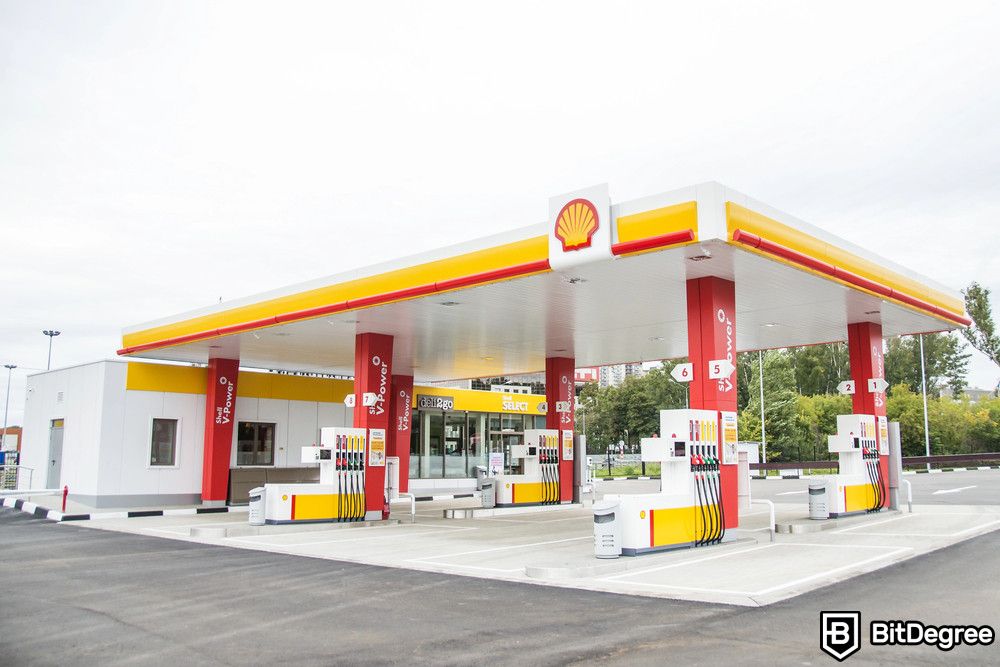
They also develop a system to track the source of sustainable aviation fuel (SAF) to meet the growing demand for eco-friendly options in the aviation sector. What’s more, this giant company implements blockchain to verify the origin of hydrogen production and renewable energy sources.
Shell contributes to several blockchain initiatives. First, Shell is part of Vakt Consortium, a blockchain platform that creates energy trade and settlement. Second, Shell partnered with Intercontinental Exchange (ICE) to build a blockchain platform for crude oil trading.
Siemens Industry Inc.
Siemens Industry Inc. is a major player in the global energy sector. This company focuses on digitalization, electrification, and automation and aims to create sustainable and reliable energy systems.
Siemens Industry Inc. issued the first-ever digital bond on a public blockchain, complying with German regulations to eliminate the need for third parties.
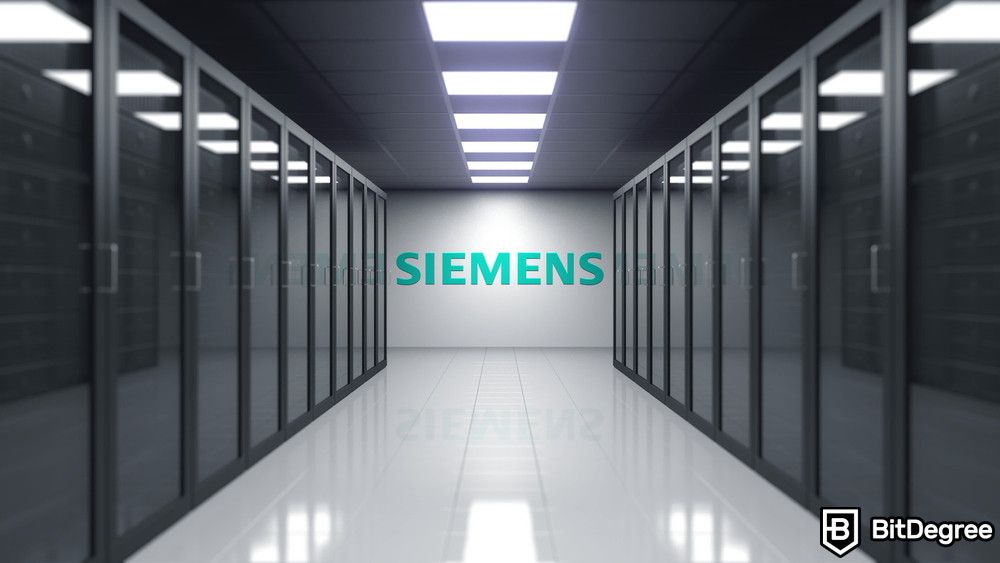
Additionally, Siemens’ Pebbles project utilizes blockchain in utilities to optimize peer-to-peer energy trading and even incorporate flexible power from electric vehicle batteries.
Speaking of Siemens' contributions, Siemens partnered with LO3 Energy to build blockchain for energy trading platforms. Another one is Blockchain Microgrid Projects. Siemens manages and distributes energy in local grids to improve energy distribution reliability.

- Secure and reliable
- Accepts fiat currencies
- Lots of trading options
- Reputable exchange
- Accepts fiat currencies
- Offers various trading options

- Huge trading variety
- Regulation-compliant around the globe
- Fair trading fees
- Beginner-friendly
- A wide array of features
- Vast number of different crypto coins & tokens

- Beginner-friendly
- Secure
- Decent trading and withdrawal fees
- Crypto.com Visa Card
- Automated tools & bots
- Ecosystem synergy with CRO
Powerledger
Powerledger is a leading blockchain technology company specializing in renewable energy markets and energy trading. Founded in 2016, they want to create a decentralized energy trading platform that lets people trade electricity safely and transparently.
Powerledger incorporates blockchain to create a peer-to-peer marketplace for energy trading. This allows consumers to buy and sell energy directly from each other.
This company aims to create a more sustainable energy ecosystem. Using blockchain energy sector, Powerledger can create microgrids where communities can manage their own energy production and consumption.

Powerledger has contributed to numerous blockchain projects. First, Powerledger, as an energy trading platform, facilitates REC trading on the blockchain. Second, the company integrates blockchain for energy into Electric Vehicle (EV) charging infrastructure, allowing transparent and automated billing.
In short, big players like Shell, Siemens, and Powerledger are using blockchain to make energy production and distribution safer, more transparent, and more efficient. They're tracking everything from equipment to sustainable fuels and even enabling peer-to-peer energy trading.
Conclusions
Incorporating blockchain for energy can transform how the industry produces, distributes, and consumes energy. It can also be the solution to solve the energy sector’s major challenges.
The blockchain energy sector provides various benefits, from cost efficiency to environmental sustainability. It has numerous applications, including energy tokenization, peer-to-peer energy trading, and smart grid management.
With the ever-changing energy investment, make sure that you choose a reliable and secure exchange that can streamline your trading. My top recommendations are Binance, Kraken, and Bybit. They offer great services and features for seamless energy token trading.
The content published on this website is not aimed to give any kind of financial, investment, trading, or any other form of advice. BitDegree.org does not endorse or suggest you to buy, sell or hold any kind of cryptocurrency. Before making financial investment decisions, do consult your financial advisor.
Scientific References
1. S. Khan, F. Loukil, C. Ghedira-Guegan, et al.: ’Blockchain smart contracts: Applications, challenges, and future trends’;
2. A. Agung, R. Handayani: ‘Blockchain for smart grid’.









